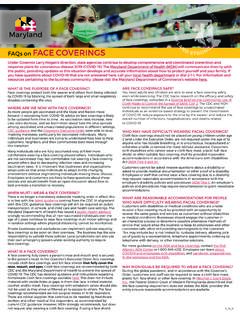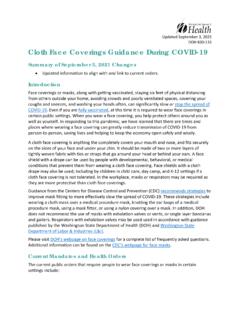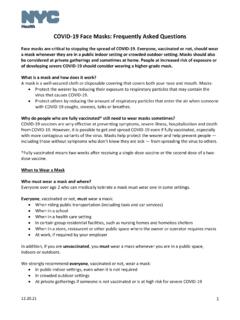Transcription of COVID-19 Guidance on the Use of Cloth Face Coverings while ...
1 COVID-19 Guidance on the Use of Cloth Face Coverings while Working Outdoors in Hot and Humid Conditions Given the evolving nature of the pandemic, OSHA is in the process of reviewing and updating this document. These materials may no longer represent current OSHA recommendations and Guidance . For the most up-to-date information, consult Protecting Workers Guidance . During the COVID-19 pandemic, OSHA generally recommends that employers encourage workers to wear Cloth face Coverings at work to help reduce the spread of COVID-19 .
2 However, workers who wear Cloth face Coverings in hot and humid environments or while performing strenuous activities outdoors, such as those in agriculture, landscaping, construction, delivery services, and oil and gas operations, can find Cloth face Coverings to be uncomfortable. Employers should follow the below practices to protect against the spread of COVID-19 and the risk of heat-related illness: Acclimatize new and returning workers to environmental and work conditions while wearing Cloth face Coverings .
3 Prioritize the use of Cloth face Coverings Photo: USDA. when workers are in close contact with others (less than 6 feet), such as during group travel or shift meetings. Increase the frequency of hydration and rest Allow workers to remove Cloth face Coverings breaks in shaded, non-enclosed, or air when they can safely maintain at least 6 feet conditioned areas. of physical distance from others. Incorporate at least 6 feet of physical Evaluate the feasibility of wearing Cloth distancing into break areas by staggering face Coverings for each worker and breaks, spacing workers, and limiting the consider alternatives ( , face shields) number of workers on break at a time, when appropriate.
4 Where feasible. Allow workers to return to personal vehicles Plan for heat emergencies and train workers during breaks to use air conditioning, when on heat stress prevention and treatment. possible. Multiple workers should generally Increase the frequency of communication to not return to the same car. workers and encourage workers to monitor If fans are used, avoid directing the fan so it themselves and others for signs of heat illness. pushes air over multiple people at the same time, since fans may increase the distance Note: Cloth face Coverings should not be used as respiratory droplets can travel.
5 A substitute for engineering and administrative controls, safe work practices, or necessary Encourage workers to use Cloth face personal protective equipment (PPE). Coverings that optimize fit and comfort, are made out of breathable, moisture-wicking For interim Guidance and other resources on materials, and use light colors when working protecting workers from COVID-19 , visit OSHA's in direct sunlight. COVID-19 webpage. Encourage workers to change Cloth face For Guidance and other resources on protecting Coverings when wet, as wet face Coverings workers from heat stress, visit OSHA's make it more difficult to breathe and are not occupational heat exposure webpage.
6 As effective. Provide clean replacement Cloth face Coverings or disposable face masks, as For Guidance on heat illness prevention during needed, for workers to change into the COVID-19 pandemic, visit the Centers for throughout the work shift. Disease Control and Prevention's webpages for Ensure workers use handwashing facilities or workers and employers. hand sanitizers with at least 60% alcohol For the latest information on the symptoms, often, as heat or moisture build-up may prevention, and treatment of COVID-19 , visit the cause workers to put on and take off Cloth Centers for Disease Control and Prevention's face Coverings frequently.
7 COVID-19 webpage. Avoid scheduling strenuous tasks during the hottest parts of the day and alter work shifts For the latest information on masks, visit the to cooler parts of the day, when possible. Centers for Disease Control and Prevention's COVID-19 and masks webpage. Allow workers to wear personal passive cooling items ( , icepack vests, cooling For the latest information on COVID-19 in bandanas) and loose-fitting and breathable the workplace, visit the National Institute clothes, as long as these items do not present for Occupational Safety and Health's a safety hazard.
8 COVID-19 webpage.















